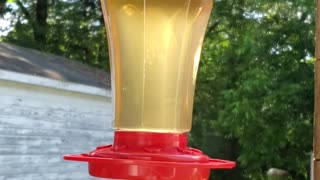Baby hummingbird waits for mama to bring dinner
Sharon, the videographer of this amazing video noticed a beautiful little hummingbird beginning to build its nest on one of her wooden wind chimes. As she watched with amazement, the parent hummingbirds tirelessly built a nest within her home made wind chime. She continued to document their progress daily during construction, and then while eggs were laid. Twig by twig the hummingbirds built their nest even while the wind chime swung in the wind. Upon completion of the nest, Sharon noticed one morning there were two tiny eggs within the nest. Keeping a watchful eye over the nest outside her kitchen window, she soon saw one egg hatching. 18 days later than the eggs were laid, one little baby hummingbird was noticed in the nest. Eager for the second to hatch, Sharon checked on the nest frequently each day. After a few days she realized that the second egg was not going to hatch, something went wrong. With one little bird awaiting its daily meal, the baby would lay motionless other than tipping its head back with a wide open mouth. As you can see in the video, the nest and its little inhabitant is as tiny as a quarter placed near the nest. Day by day the baby is growing. Hummingbirds are the smallest of birds, most species measuring 7.5–13 cm (3–5 in) in length. The smallest existant bird species is the 5 cm (2.0 in) bee hummingbird, which weighs less than 2.0 g (0.07 oz). Native to the Americas these adorable little birds can usually be heard before seen. Their rapid wing-flapping rates, which vary from around 12 beats per second in the largest species, to in excess of 80 beats per second in some of the smallest. This high rate of speed of their wing flapping allows them to actually hover in one place just like a helicopter. Along with their high speed wing flutter comes extreme flight speeds from these little guys. Their top speeds exceed 34 miles per hour (54 km/h) and some species can dive at speeds in excess of 49 miles per hour (79 km/h). Hummingbirds have the highest mass-specific metabolic rate, meaning they consume the most energy per unit of time, of any homeothermic animals ( animals that maintain a steady internal body temperature regardless of the surrounding temperatures). To conserve energy when food is scarce, and nightly when not foraging, they can go into torpor, a state similar to hibernation, slowing their metabolic rate to 1/15th of its normal rate. These little creatures are surely amazing.
-
 1:00
1:00
WTMJMilwaukee
3 years agoWhat's for Dinner? - Baby Back Ribs
48 -
 0:56
0:56
ViralHog
4 years ago $0.88 earnedBaby Hummingbird Makes Surprise Appearance
1.57K5 -
 0:31
0:31
Jbae6793
3 years ago $0.02 earnedBeautiful hummingbird flying.
1461 -
 0:35
0:35
madtown95
3 years ago $0.16 earnedA hummingbird
4.13K -
 0:39
0:39
ImagesByOla
3 years agoThirsty Lil Hummingbird
4371 -
 0:19
0:19
DelightfulVideos
3 years agoRuby-Throated Hummingbird
1301 -
 0:52
0:52
fcalvin
3 years agoHummingbird release
1051 -
 0:21
0:21
TheDad58
3 years agoHummingbird visit
110 -
 0:52
0:52
cdngreenwaterdiver
4 years agoBaby Hummingbird Awaits a Meal With Wide Open Mouth
912 -
 0:32
0:32
talks23
3 years ago $0.02 earnedOut for dinner
102